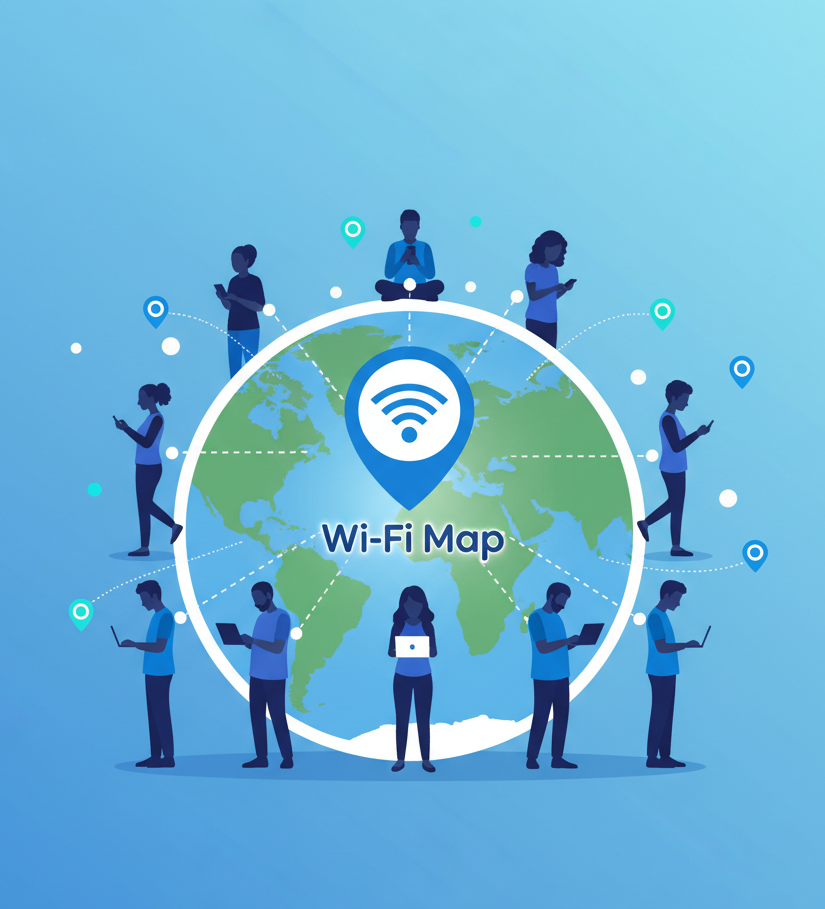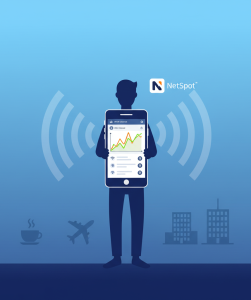In today's hyperconnected world, being without the internet seems almost unthinkable. Whether it's for working remotely, studying, browsing social media, or simply finding your way around an unfamiliar city, connectivity is essential. However, mobile data plans can be expensive and limited, especially when traveling internationally. It's in this scenario that the fundamental question arises for many: how to find free Wi-Fi networks with app safely and efficiently? The answer could be in the palm of your hand, in a application that transformed the search for connectivity into a collaborative and global experience: Wi-Fi Map.
This comprehensive guide explores every aspect of Wi-Fi Map, a powerful tool that stands out as one of the most robust solutions for those looking to find free internet in virtually any corner of the planet. Throughout this... article, we'll uncover not only how it works, but also its hidden features, security tips, and a detailed step-by-step guide so you can get the most out of this platform. So, if you're tired of spending fortunes on mobile data or begging for passwords in cafes, keep reading and discover how free connectivity is closer than you think.
What is Wi-Fi Map and how does it work?
First and foremost, it's crucial to understand the genius behind Wi-Fi Map. Launched in 2014, the app isn't just a network locator; it's, at its core, the world's largest global Wi-Fi sharing community. The premise is simple and powerful: users from all over the world add and update Wi-Fi access points, including their passwords, on an interactive map. Consequently, this collaborative database has already surpassed 150 million hotspots, a number that grows every day.
The operation is based on the principle of crowdsourcingImagine you're at a restaurant and receive the Wi-Fi password. You can voluntarily open Wi-Fi Map and add that network and password so other users in the community can access it in the future. Similarly, when you need a connection, simply open the app to see all the hotspots shared by others around you.
This community-based approach solves one of the biggest problems with finding Wi-Fi: the need for passwords. Additionally, the app frequently includes helpful tips from other users, such as "the password is the phone number on the wall" or "the strongest signal is near the window." In this way, Wi-Fi Map transforms the often frustrating task of searching for a connection into a simple, straightforward, and incredibly effective experience.
WiFi Map・Password, Internet, eSIM
Android
Main Wi-Fi Map Features You Need to Know
Wi-Fi Map has evolved significantly since its launch and now offers a complete ecosystem of connectivity tools. While searching for free networks is its core functionality, its additional features make it a true Swiss Army knife for any traveler or digital nomad.
Interactive Access Point Map
The heart of the app is undoubtedly its interactive map. When you open it, your location is pinpointed via GPS, and the map displays icons representing all nearby Wi-Fi hotspots. Networks are typically color-coded or marked with symbols indicating whether they're public, private with a shared password, or owned by commercial establishments. With just one tap, you can see the network name, the distance to it, and, most importantly, access details like the password. The interface also allows you to filter results, making it easier to search for specific types of locations, such as cafes, airports, or libraries.
Community Passwords and Tips
As mentioned, Wi-Fi Map's strength lies in its community. For each hotspot, there's a section where users can add and verify passwords. If a password worked for you, you can confirm it with an upvote, helping keep the database relevant and up-to-date. Conversely, if a password is incorrect, you can flag it. This continuous feedback system ensures the information is as accurate as possible, although, as with any collaborative system, outdated passwords can occasionally be a problem.
Offline Functionality: Connection Without Internet
This is perhaps the most valuable feature for travelers. What happens when you arrive in a new country and don't have a data plan to open the app and search for Wi-Fi? Wi-Fi Map solves this with its offline maps. Before your trip, you can download the Wi-Fi map for an entire city or country. This way, when you arrive at your destination, even without a 3G/4G/5G connection, you can open the app and browse the offline map to find the nearest hotspots, guided by your phone's GPS. This feature is a true lifesaver and a clear example of how to find free Wi-Fi networks with app in a planned and intelligent way.
Integrated Speed Test
Finding a Wi-Fi network is only half the battle; the other half is ensuring it's fast enough for your needs. There's no point connecting to a network if it can barely load a web page. With this in mind, Wi-Fi Map includes a speed test tool. After connecting to a network found by the app, you can run a test to check download and upload speeds, as well as latency (ping). This helps you decide whether it's worth staying there for an important video call or a large upload.
Secure VPN for Protected Browsing
Security is a primary concern when using public Wi-Fi networks, which are notoriously vulnerable to data interception attacks. Wi-Fi Map addresses this issue by offering a built-in VPN (Virtual Private Network) service. When you activate the VPN, all your internet traffic is encrypted and routed through a secure server, making it virtually impossible for hackers or eavesdroppers on the same network to monitor your activity. While the VPN service is a premium (paid) feature, it adds an essential layer of security for those who need to conduct banking transactions or handle sensitive information on open networks.
eSIM: Global Mobile Data
Further expanding its reach, Wi-Fi Map now offers an eSIM service. An eSIM is a digital chip that allows you to activate a mobile data plan without the need for a physical SIM card. Through the app, you can purchase data packages for over 70 countries directly from your phone (as long as it supports the technology). This functionality positions Wi-Fi Map not only as a tool for finding free Wi-Fi, but as a complete global connectivity solution, offering a convenient alternative to expensive international roaming plans.
Step by Step: How to Use Wi-Fi Map to Find Free Wi-Fi
Using Wi-Fi Map is a fairly intuitive process. If you're wondering, how to find free Wi-Fi networks with app in practice, follow these simple steps:
- Download and Installation: First, download the Wi-Fi Map app from the Google Play Store (Android) or the App Store (iOS). Installation is quick and the app is free to download, although it offers an ad-free Pro version with additional features.
- Initial Permissions: When you first open the app, it will ask for permission to access your location. Granting this permission is essential so it can display nearby Wi-Fi hotspots.
- Explore the Map: Immediately, the main map will appear, showing your location and nearby hotspots. You can navigate the map by dragging your finger or use the search function to find a specific area.
- Select an Access Point: Tap one of the Wi-Fi icons on the map. A small window will appear with the network name and, in some cases, the distance. Tap again to see full details.
- Get Password: On the details screen, you'll see the "Show Password" option. Tapping it will reveal the password shared by the community. You can easily copy it to your clipboard.
- Connect to the Network: Now, go to your smartphone's Wi-Fi settings, find the network in the list of available networks, select it, and paste the password you copied.
- Contribute to the Community (Optional): Once you've successfully connected, you can return to the app and confirm that the password worked. If you find a new network or an updated password, consider adding it to help other users.
Advantages and Disadvantages of Wi-Fi Map
No tool is perfect. To provide a complete analysis, it's important to weigh the pros and cons of Wi-Fi Map.
Advantages: Why Does Wi-Fi Map Stand Out?
- Gigantic Database: With over 150 million hotspots, it is the largest network of its kind in the world.
- Offline Functionality: The ability to download maps is a decisive advantage for international travel.
- Intuitive Interface: The app is easy to use, even for less tech-savvy users.
- Additional Resources: The inclusion of speed testing, VPN, and eSIM makes it a complete connectivity solution.
- Active Community: The collaborative nature ensures that new networks are constantly being added.
Disadvantages and Precautions to Be Taken
- Outdated Passwords: Due to community dependency, some passwords may be incorrect or out of date.
- Security Risks: Connecting to unknown public networks always poses security risks. Using the built-in VPN (which is a paid feature) is highly recommended.
- Ads in the Free Version: The free version of the app displays ads, which may be annoying for some users.
- Connection Quality: The app shows you where Wi-Fi is, but cannot guarantee the quality or speed of the connection.
Is Wi-Fi Map Safe? Tips for Protecting Yourself on Public Networks
The question of security is perhaps the most important. The Wi-Fi Map app itself is secure. It doesn't hack networks; it simply serves as a repository for voluntarily shared passwords. The risk isn't the app itself, but rather the nature of the public Wi-Fi networks it provides access to.
So, when using Wi-Fi Map or any other way to connect to a public network, follow these security tips to protect your data:
- Always Use a VPN: If you plan to do more than just browsing, activate a VPN. This encrypts your data, protecting it from prying eyes.
- Avoid Sensitive Transactions: Avoid accessing your bank, shopping online, or entering important passwords while on a public network, even with a VPN.
- Check “HTTPS”: When browsing the web, make sure the sites you visit use the protocol
HTTPS(the padlock next to the address in the browser). This indicates that your connection to that specific website is encrypted. - Keep Your Software Up to Date: Make sure your device's operating system and applications (especially your browser and antivirus) are always up to date with the latest security patches.
- Disable File Sharing: Make sure your device's file and printer sharing options are turned off to prevent others on the same network from accessing your files.

Conclusion: The Key to Universal Connectivity
In a world that demands constant connection, Wi-Fi Map establishes itself not only as a useful tool, but as an indispensable travel companion. It democratizes internet access, transforming it into a shared and globally accessible resource. The platform brilliantly demonstrates this. how to find free Wi-Fi networks with app can be a practical, safe and efficient reality, as long as the user takes the necessary precautions.
By combining a massive collaborative map with essential features like offline access, speed testing, and an extra layer of VPN security, Wi-Fi Map goes beyond being a simple password finder. It becomes a complete solution for global citizens, students on a budget, digital nomads, and anyone who values the freedom of always being connected without having to worry about exorbitant mobile data costs. The next time the 4G icon disappears, remember that a community of millions of people may have already shared the key to your next connection.



